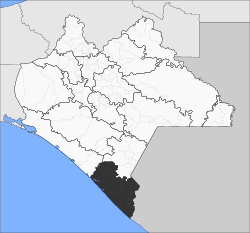
Back Soconusco Catalan Soconusco Czech Soconusco (Region) German Sokonusko Esperanto Soconusco Spanish Soconusco Basque Soconusco Finnish Soconusco French Soconusco ID Soconusco Italian
Soconusco | |
|---|---|
 Streets of Tapachula in Chiapas | |
 Map of Soconusco in Chiapas | |
| Country | |
| State | |
| Largest city | Tapachula |
| Area | |
• Total | 4,661.3[1] km2 (1,799.74 sq mi) |
| Population (2020) | |
• Total | 821,707[1] |
| • Density | 176.28/km2 (456.57/sq mi) |
| Demonym | Soconuscan |
| Time zone | UTC-06:00 |
| Dialect(s) | Mexican Spanish |
15°18′56.14″N 92°43′35.01″W / 15.3155944°N 92.7263917°W
Soconusco is a region in the southwest corner of the state of Chiapas in southeastern Mexico along its border with Guatemala. It is a narrow strip of land wedged between the Sierra Madre de Chiapas mountains and the Pacific Ocean. It is the southernmost part of the Chiapas coast extending south from the Ulapa River to the Suchiate River, distinguished by its history and economic production. Abundant moisture and volcanic soil has always made it rich for agriculture, contributing to the flowering of the Mokaya and Olmec cultures, which were based on Theobroma cacao and rubber of Castilla elastica.
In the 19th century, the area was disputed between Mexico and Guatemala until a treaty signed in 1882 fixed the modern border by dividing the area's historical extension, with most going to Mexico and a smaller portion east of the Suchiate to Guatemala. In 1890, Mexican president Porfirio Díaz and German chancellor Otto von Bismarck collaborated to take advantage of southern Mexico's agricultural potential by sending 450 German families to Soconusco near Tapachula in the southern state of Chiapas. Extensive coffee cultivation quickly made Soconusco one of the most successful German colonies, and between 1895 and 1900, 11.5 million kg of coffee had been harvested. Fincas (estates) were erected in the Chiapaneco jungle and given German names such as Hamburgo, Bremen, Lübeck, Argovia, Bismarck, Prussia, and Hanover.
This area has experienced a boom-and-bust economy with well-studied migration patterns of agricultural workers. After exporting cacao to central Mexico for thousands of years, the first modern crop for export was coffee. Since then other crops such as tropical fruits, flowers and more have been introduced. The most recent addition is the rambutan, a southeast Asian fruit.
- ^ a b "Census of Population and Housing 2020". National Institute of Statistics and Geography. Retrieved February 16, 2025.
© MMXXIII Rich X Search. We shall prevail. All rights reserved. Rich X Search